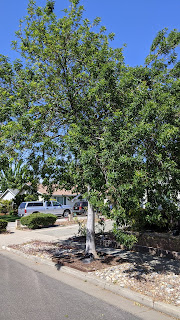Pineapple guava - Feijoa sellowiana

The pineapple guava, or feijoa , i s very uncommon in Sunnyvale. It is a species of flowering plant in the myrtle family and is native to the highlands of South America. It is not related to either a pineapple or a guava , but the taste of the small fruit has been described as a cross between pineapple and guava . Since the fruit is very soft and easy to bruise, it is rarely found in stores. It is an evergreen shrub 20 feet in height and is widely grown in New Zealand. It has a very interesting crusty bark. The pineapple guava below is located on the corner of 905 Inverness Way (along Meadowlark Lane). The fruit, known as feijoa, matures in autumn and is green, shaped like an ellipsoid. It is about the size of a chicken egg. The leaves are light green, thick, and somewhat leathery, with soft gray undersides. Where to find them: There are no pineapple guava trees planted by the city. The pineapple guava above was planted by a previous homeowner on the side of 905 Inve





